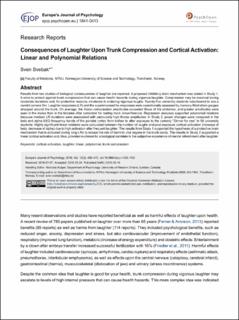| dc.contributor.author | Svebak, Sven | |
| dc.date.accessioned | 2020-06-08T06:47:54Z | |
| dc.date.available | 2020-06-08T06:47:54Z | |
| dc.date.created | 2016-12-05T13:18:02Z | |
| dc.date.issued | 2016 | |
| dc.identifier.citation | Europe's Journal of Psychology. 2016, 12 (3), 456-472. | en_US |
| dc.identifier.issn | 1841-0413 | |
| dc.identifier.uri | https://hdl.handle.net/11250/2657074 | |
| dc.description.abstract | Results from two studies of biological consequences of laughter are reported. A proposed inhibitory brain mechanism was tested in Study 1. It aims to protect against trunk compression that can cause health hazards during vigorous laughter. Compression may be maximal during moderate durations and, for protective reasons, moderate in enduring vigorous laughs. Twenty-five university students volunteered to see a candid camera film. Laughter responses (LR) and the superimposed ha-responses were operationally assessed by mercury-filled strain gauges strapped around the trunk. On average, the thorax compression amplitudes exceeded those of the abdomen, and greater amplitudes were seen in the males than in the females after correction for resting trunk circumference. Regression analyses supported polynomial relations because medium LR durations were associated with particularly high thorax amplitudes. In Study 2, power changes were computed in the beta and alpha EEG frequency bands of the parietal cortex from before to after exposure to the comedy “Dinner for one” in 56 university students. Highly significant linear relations were calculated between the number of laughs and post-exposure cortical activation (increase of beta, decrease of alpha) due to high activation after frequent laughter. The results from Study 1 supported the hypothesis of a protective brain mechanism that is activated during long LRs to reduce the risk of harm to vital organs in the trunk cavity. The results in Study 2 supported a linear cortical activation and, thus, provided evidence for a biological correlate to the subjective experience of mental refreshment after laughter. | en_US |
| dc.language.iso | eng | en_US |
| dc.publisher | PsychOpen | en_US |
| dc.rights | Navngivelse 4.0 Internasjonal | * |
| dc.rights.uri | http://creativecommons.org/licenses/by/4.0/deed.no | * |
| dc.title | Consequences of laughter upon trunk compression and cortical activation: Linear and polynomial relations | en_US |
| dc.type | Peer reviewed | en_US |
| dc.type | Journal article | en_US |
| dc.description.version | publishedVersion | en_US |
| dc.source.pagenumber | 456-472 | en_US |
| dc.source.volume | 12 | en_US |
| dc.source.journal | Europe's Journal of Psychology | en_US |
| dc.source.issue | 3 | en_US |
| dc.identifier.doi | 10.5964/ejop.v12i3.1102 | |
| dc.identifier.cristin | 1408318 | |
| dc.description.localcode | This is an open access article distributed under the terms of the Creative Common sAttribution License (http://licenses/by/3.0), which permits unrestricted use, distribution,and reproduction in any medium, provided the original work is properly cited | en_US |
| cristin.ispublished | true | |
| cristin.fulltext | original | |
| cristin.qualitycode | 1 | |

